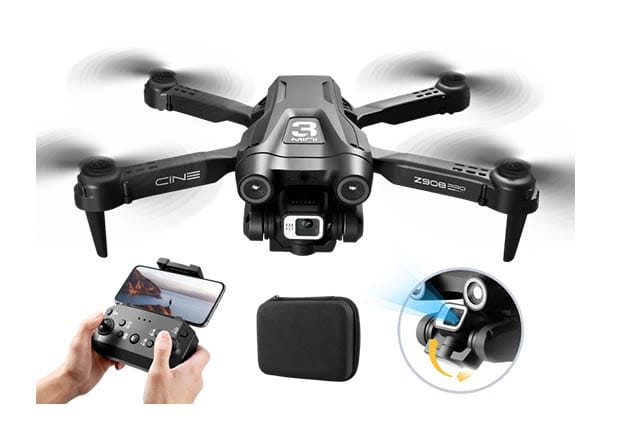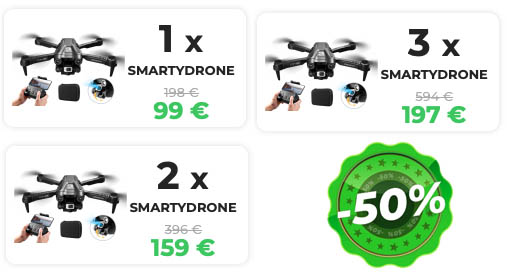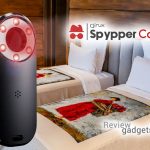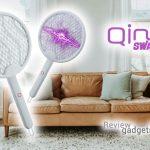I tested the SmartyDrone for two weeks. I wanted to answer a very specific question: can a sub-€100 drone—lightweight, foldable, and with “4K” on the box—deliver a convincing experience for someone getting into aerial photography or simply filming family videos without hassle? After several flight sessions, a few wind scares, and lots of footage, here’s my verdict.

What exactly is the SmartyDrone?
It’s a foldable drone weighing 138 grams (battery included), with a dual camera system—a motorized front camera and a downward camera for optical flow—electronic stabilization, and a traditional 2.4 GHz controller with four channels and a left-hand throttle. The SmartyDrone claims up to 15 minutes of flight per battery (3.7 V, 2000 mAh), USB charging in about 60 minutes, and a theoretical control range up to 200 meters in interference-free environments. For video and first-person view (FPV) it uses its own Wi-Fi, with image transmission between 50 and 80 meters in ideal conditions. While I was testing it, I saw it offered at €99, with multi-unit bundles that lower the per-unit price.
Design, materials & portability
The SmartyDrone chassis combines plastic with metal reinforcements at key stress points. Folded, it slips into a small backpack with no effort (13 × 9 × 5 cm). Unfolded, it has a 25 × 25 cm footprint and stands just 5 cm tall. The front camera tilts remotely up to 148°, letting you jump from top-down shots to horizon-level framing without moving the drone itself. The controller’s phone clamp fits handsets up to 5.5”—fine for compact phones; larger phones are right on the edge but fit if you’re not using a bulky case.
The included prop guards (four tool-free rings) are a welcome touch for indoor flights: a brush with a wall won’t instantly mean a broken prop. The box also includes four spare props, a screwdriver, a carry pouch, and manuals (for the drone and the app).

Setup and first flight
Nothing complicated: charge the battery, power on the drone, pair the controller (takes seconds), calibrate with the classic sticks-to-corners gesture, and you’re good. One-button takeoff and landing make first flights much easier. For FPV and mobile recording, open the app and connect to the drone’s Wi-Fi; in under a minute you’re seeing what the camera sees.
The SmartyDrone app mirrors most controller functions: takeoff/landing, slow/fast modes, camera switching, photo/video, on-screen drawn paths, tilt-to-fly, and even face-triggered shutter. No account creation or data sharing required: connect and fly.
How does it fly? Stabilization & control
The SmartyDrone doesn’t include GPS; it relies on optical flow (the downward camera “reads” the ground) and a barometer to hold altitude. In practice, this means that indoors or outdoors over textured surfaces (grass, dirt, cobblestone) the drone hovers quite steadily. Over uniform surfaces (e.g., water or shiny pavement) optical flow is less reliable and you’ll notice a slight drift you’ll need to counter with the stick.
In a light breeze it copes well; in gustier conditions it demands quicker hands. Slow mode is perfect for learning and for smooth shots; fast mode is more reactive and allows snappier direction changes. Headless mode helps beginners, but once you gain confidence it’s better to fly with real orientation and make the most of the remotely tilting front camera, which expands your creative options without repositioning the drone.
The 2.4 GHz controller response is consistent within 100–120 meters in open urban areas. In the countryside it approached the maker’s claims, provided there was little interference. Wi-Fi FPV is the bottleneck: at 50–60 meters it maintains video with moderate latency; beyond that, it’s very environment-dependent. That’s typical for beginner drones with Wi-Fi links.

Camera & image quality
The manufacturer touts “4K” for photos (4096 × 2016) and 2.5K (2560 × 1440) for video. In practice, what matters isn’t just resolution but also the sensor, optics, and bitrate. What did I see? In daylight with good light, I got clean, stable clips for social media, with slightly saturated colors and enough sharpness for big screens as long as you don’t crop heavily. At dusk, noise increases, so it’s best to slow things down or pick scenes with gentler contrast.
Stabilization on the SmartyDrone isn’t mechanical (no 3-axis gimbal); it’s electronic: it smooths minor vibrations and does a good job if you fly with broad, controlled movements. The ability to tilt the angle from the controller is a game-changer at this price: you can plan top-down to horizon transitions that look cinematic without fighting the drone’s position. The downward camera isn’t for “b-roll,” but for optical flow; still, it can do simple overhead shots at low altitude.
If you’re coming from a “premium” drone you’ll miss dynamic range and bitrate, but as a first drone or a grab-and-go beater for trips, it holds up well. Video files are light and easy to edit on your phone.
Sensors, safety & pilot aids
It includes front and side proximity sensors for basic anti-collision. Think of them as a simple safety net: indoors and at low speed, they spot obstacles and prevent light brushes against walls or furniture. They’re no replacement for advanced 3D mapping, but they avoid mishaps while you learn. Add flips (360° roll) for a bit of acro fun (best outdoors with altitude), a one-key return button, and fine trim adjustments, and you’ve got a very instructive package.
Battery life & charging
With mixed flights—active FPV, altitude changes, a few tricks—I averaged 11 to 13 real minutes per battery. In continuous hover without recording, I touched 15 minutes. USB charging takes around an hour; if you plan longer sessions, a second battery completely changes the experience. The controller uses three AAA cells; with rechargeables you can forget about them for weeks.

Range & link reliability
The 2.4 GHz control link is solid for what the SmartyDrone is designed for. With Wi-Fi FPV, it’s wise to be conservative: to keep smooth video and precise control, my comfort zone was up to 60 meters with line of sight. If you’re going to fly farther, prioritize safety: maintain visual line of sight, avoid interference (crowds, Wi-Fi-dense areas), and remember that regulations in most recreational scenarios require VLOS.
The app: more than a viewer
Beyond viewing and recording, the app offers draw-to-fly paths, tilt-to-control, auto-shutter on face detection, and camera switching. For quick “social-ready” clips, the path feature is handy: sketch an “S”, the drone follows it at a steady pace, and you focus on framing. Face detection works best in good light; at night or in strong backlight it’s hit-and-miss, which is normal at this price.
Where it shines—and where it doesn’t
It shines when:
- You want to learn with a lightweight, non-intimidating drone.
- You’re after eye-catching shots without investing in a gimbal.
- You’ll fly indoors or nearby outdoors and value one-button takeoff/landing and prop guards.
It struggles when:
- You need professional video with a 3-axis gimbal and high bitrate.
- You want hundreds of meters of range with uninterrupted FPV.
- You’ll often fly in moderate to strong wind.
Regulations & peace of mind
At 138 grams, the SmartyDrone sits below the 250-gram threshold that, in Europe, simplifies recreational rules in the Open category. Even so, always check local rules, keep line of sight, respect max altitudes, and avoid no-fly zones. Common sense is as important as any sensor.
A quick reality check vs the big leagues (no drama)
High-end drones offer GPS/GNSS, a mechanical gimbal, kilometer-long ranges, and higher bitrates. They also weigh—and cost—several times more. The SmartyDrone isn’t trying to compete there; its mission is to give you solid fundamentals for the hobby: take off, stabilize, frame, record, and learn. As a first purchase or a travel backup, it delivers on its promises and puts a smile on your face more often than you’d expect at this price.
Tips after testing
- Calibrate compass/gyros on first use and when you change flying areas.
- Pre-tilt the camera with the controller before each shot: adjusting in flight gives you much richer footage.
- Fly in good light: this camera performs best by day.
- Don’t run the battery to 0%: land with 15–20% to prolong its life.
- For FPV, favor shorter distance and more precision: your videos will look better and you’ll fly more calmly.
Price & Special Offers
Looking for a compact, capable, easy-to-fly drone to capture your adventures from above? The SmartyDrone is currently available with an irresistible launch deal: 50% off and free shipping. For a limited time, you can get this foldable drone with dual 4K cameras, anti-collision sensors, and electronic stabilization for just €99 instead of €198 .

This promotion depends on stock availability, so if you’re thinking about getting into aerial photography—or you need a great gift—now’s the perfect time to jump on the offer. The image quality, ease of use, and smart features of the SmartyDrone make it one of the most complete choices in its price range.
Activate the 50% discount from this link
How to buy
- Go to the official site and check availability from this link.
- Choose how many drones you want (the more units, the bigger the per-unit savings).
- Enter your shipping details and pay securely.
- Receive your SmartyDrone at home and start flying in minutes.
Units are selling fast, so if you’re interested, place your order soon to avoid missing out.
Purchase Guarantee
The SmartyDrone comes with a 30-day satisfaction guarantee. If it doesn’t meet your expectations—or you simply change your mind—you can request a full refund with no hassle.
All shipments include tracking and are protected against transit damage.
What other users are saying
With more than 1,260 reviews and an average score of 4.7 out of 5 on TrustScore, the SmartyDrone has quickly earned the trust of people looking for a reliable, affordable, and fun way into the world of drones. Here are some standout reviews:
James Martin ★★★★☆ (4.8/5)
“I bought the SmartyDrone to film my hiking routes, and it’s exceeded every expectation. It’s very easy to fly, even with a light breeze. The adjustable front camera is fantastic for getting different angles without moving the drone.”
Laura Bennett ★★★★☆ (4.6/5)
“I used it at a family gathering in the countryside and everyone wanted a turn. We flew for over an hour with two batteries. The videos look amazing, and I’d never touched a drone before.”
Robert Sanders ★★★★★ (5.0/5)
“I’ve tested mid-range drones for a while and this one, for the price, is very well thought out. The controller is responsive, FPV has no noticeable lag at short distances, and the path feature is perfect for automatic shots.”
Grace Roberts ★★★★☆ (4.7/5)
“It’s clearly not a pro drone, but for learning, family videos, and taking it everywhere without worry, it’s ideal. Fold it up, drop it in your bag, done. Perfect as a gift or a first step into this world.”
Activate the 50% discount from this link
SmartyDrone FAQ
Does the SmartyDrone really record in 4K?
Yes, though remember it’s an entry-level drone. Resolution is 4096×2016 for photos and 2560×1440 for video. Quality is excellent in good light, but don’t expect the same performance as an €800 drone. For social media and home use, it’s more than enough.
How long does a single charge last?
It depends on how you fly. In a relaxed mode while recording with the front camera, you can expect around 13 to 15 minutes. Lots of maneuvers or using both the camera motors and FPV transmission will shorten that a bit. The battery fully charges in about an hour with the included USB cable.
Do I need a license or registration to fly it?
No. At 138 grams, the SmartyDrone sits below the threshold requiring registration or training in many European countries, including Spain. Even so, it’s recommended to fly in safe areas, maintain direct visibility, and follow local rules.
Can I use it indoors?
Absolutely. It even includes anti-collision sensors that make it ideal for enclosed spaces. Just take off in a draft-free area with good lighting so the optical-flow sensors can work properly.
What if it crashes or I damage a prop?
The package includes four spare props and a screwdriver, so you can handle minor repairs yourself in minutes. There’s also a protective prop frame, which is recommended if you’re just starting out or flying indoors.
Do I need to download an app?
Yes. To use first-person view (FPV), record straight to your phone, and enable features like path or face detection, you’ll need the maker’s free app. The manual includes step-by-step instructions.
Activate the 50% discount from this link
Will it work with my phone?
Most Android and iOS smartphones are compatible. The controller mount fits phones up to 5.5 inches, though many users have used larger models by removing the case. Just connect to the drone’s Wi-Fi and open the app.
What sets the SmartyDrone apart from other cheap drones?
The motorized, adjustable camera, anti-collision sensors, FPV quality, and the fact that it’s easy to fold and pack help it stand out among similarly priced models. It’s built to feel intuitive and fun from minute one.
Conclusion & verdict
The SmartyDrone is exactly what it promises: a light, foldable, affordable drone that makes learning easy and delivers very respectable footage in fair weather with steady hands. Its electronic stabilization and motorized front camera let you play director without wrestling physics, and its automatic modes lower the barrier for anyone starting from zero. The Wi-Fi FPV link and lack of GPS define its limits, but they don’t overshadow an experience that’s fun, honest, and—most importantly—fair for the price.
If you want your first drone to learn, capture family memories, or create lightweight content for social media, it’s a great buy at €99. If you’re chasing cinematic shots in wind and long-distance flights, keep this as a beater drone and look at higher tiers later. In the meantime, the SmartyDrone will give you hours of flight time and plenty of usable clips—without breaking the bank.





